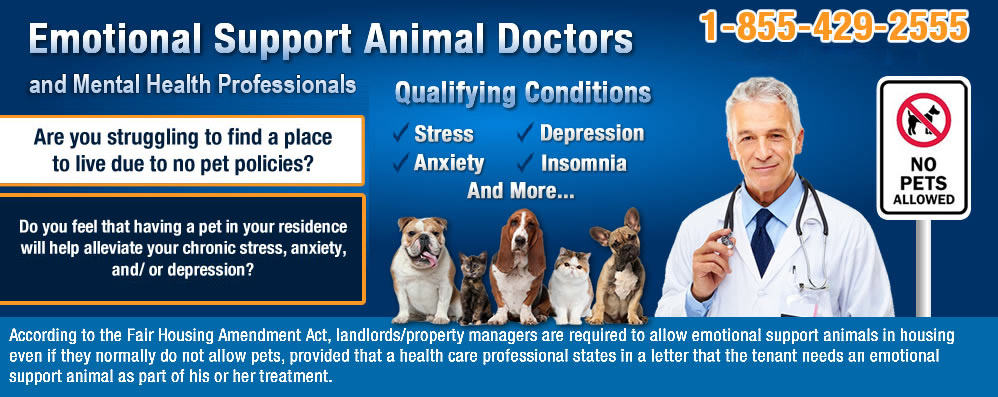Emotional Support Animal Certification
Thousands of pet owners register their pets as certified emotional support animals (ESA) each year. And the numbers continue to grow as more people become aware of the unique benefits that come from having access to non-human emotional support.
But there are still many questions about how the process of emotional support animal certification works. In this post, learn what qualifies an animal to serve as an ESA, how to obtain certification, important legal guidelines, how to travel with your ESA and other essentials.
About Emotional Support Animal (ESA) Certification
An emotional support animal certification includes two components.
The first is a letter from a licensed mental health professional stating that you have a need for the company of an ESA for mental health reasons. These reasons may include social anxiety, depression, panic attacks and any other disability currently recognized by the Diagnostic Standards Manual (vs. 4 or 5).
The letter must include all of the following to be considered certified:
– It is written on the provider’s official stationery.
– The letter is dated and signed.
– It includes a description the nature of the mental health issue you are being treated for and how it limits you from engaging in at least one important life activity.
– The therapist’s assertion that you have been given a formal prescription for an emotional support animal.
The second is voluntary rather than mandatory, but can offer great legitimacy if the need arises. This is registration of your emotional service animal with a national registry. There are many such available registries and a simple internet search can locate several options to choose from.
Are Emotional Support Animals Allowed in No-Pet Housing?
Under the Fair Housing Amendments Act of 1988, tenants that have been prescribed a service animal or an emotional support animal must be permitted to reside in the rental property along with their animal.
If the building won’t easily accommodate animals, the landlord must make reasonable adjustments to make it possible for you and your animal to live there together.
There are 4 exceptions to this law:
– If the rental unit was leased without the assistance of an agent.
– If the property includes 4 or fewer units and the landlord lives in one of those units.
– Private clubs are exempt.
– Hotels and motels are exempt.
You must provide your certification letter upon demand. You may also be required to provide additional verification from a doctor or a second licensed mental health professional.
Can I Fly With My Emotional Support Animal & If So, What are the Rules?
The short answer to this question is “yes.” According to the Air Carrier Act (ACA), you must be permitted to fly with your ESA as long as you can provide the required documentation.
In order to fly with your ESA, you must provide:
– A verification letter stating that you have a formal prescription from a licensed mental health professional for an emotional service animal.
– A photo I.D. that shows your animal as a certified emotional support animal.
– Badges to place on your animal’s cage and/or leash.
Once verified, your animal must be permitted to fly with you free of charge.
How Can I Get My Dog An Emotional Support Dog Certification?
Whether you use our service to certify your dog with one of the mental health professionals in our network, or you have a doctor of your own who is willing to write the letter, that is all you need. If you would like to use our services, you can click on the ONLINE EXAM to get started with the online exam. Upon submitting the online exam, a mental health professional will contact you and write a letter for you if they feel you qualify. If they don’t approve you, you’ll get a same-day 100% refund to your card.
Do I Need to Formally Register My Dog With an Online Registry?
No,the only thing you are required by law to do is get a letter written for you by a licensed mental health professional if you wish to be able to do these 3 things with your animal accompanying you:
– Fly with your animal in the cabin and have your animal fly free under the protections afforded you in the Air Carrier Act.
– Rent accommodations where you can live with your animal without paying a pet deposit even if the tenancy specifies “no pets” under the protections afforded you by the Fair Housing Act.
Do I Have to Train My ESA Before Seeking Certification or Registration?
An emotional support animal provides you with support simply with their presence. No formal training is required to serve as an ESA.
However, it is wise to ensure your animal can display calm, self-controlled behavior in a diverse number of public settings, or you risk getting asked to leave for reasons of disruption.
Do I Need Anything Else Other Than a Prescription Letter?
No, you do not need to formally register your animal as an emotional support animal to have your animal live or fly with you.
However, if you wish to fly with your animal under the Air Carrier Act, receive protections under the Americans With Disabilities Act or live with your animal under the Fair Housing Act, you must certify dog as emotional support animal with a mental health professional and be able to produce proof of the letter upon request.
Under the Fair Housing Act, landlords are also permitted to require that you obtain a letter from a physician or licensed mental health professional verifying your prescription.


